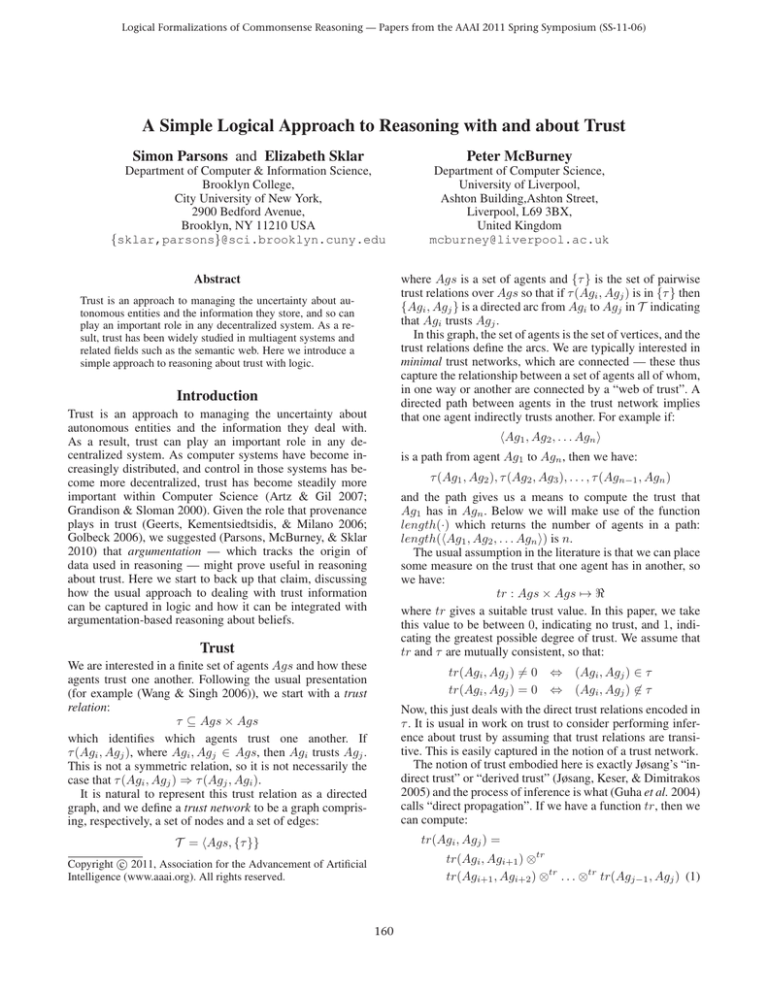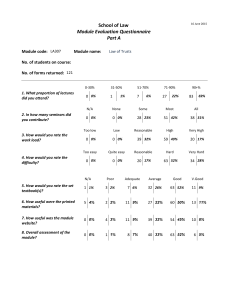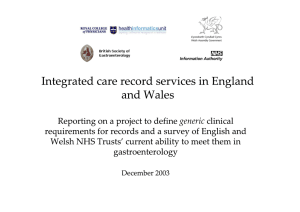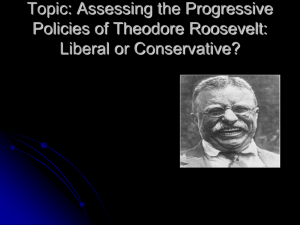
Logical Formalizations of Commonsense Reasoning — Papers from the AAAI 2011 Spring Symposium (SS-11-06)
A Simple Logical Approach to Reasoning with and about Trust
Simon Parsons and Elizabeth Sklar
Peter McBurney
Department of Computer & Information Science,
Brooklyn College,
City University of New York,
2900 Bedford Avenue,
Brooklyn, NY 11210 USA
{sklar,parsons}@sci.brooklyn.cuny.edu
Department of Computer Science,
University of Liverpool,
Ashton Building,Ashton Street,
Liverpool, L69 3BX,
United Kingdom
mcburney@liverpool.ac.uk
where Ags is a set of agents and {τ } is the set of pairwise
trust relations over Ags so that if τ (Agi , Agj ) is in {τ } then
{Agi , Agj } is a directed arc from Agi to Agj in T indicating
that Agi trusts Agj .
In this graph, the set of agents is the set of vertices, and the
trust relations define the arcs. We are typically interested in
minimal trust networks, which are connected — these thus
capture the relationship between a set of agents all of whom,
in one way or another are connected by a “web of trust”. A
directed path between agents in the trust network implies
that one agent indirectly trusts another. For example if:
Abstract
Trust is an approach to managing the uncertainty about autonomous entities and the information they store, and so can
play an important role in any decentralized system. As a result, trust has been widely studied in multiagent systems and
related fields such as the semantic web. Here we introduce a
simple approach to reasoning about trust with logic.
Introduction
Trust is an approach to managing the uncertainty about
autonomous entities and the information they deal with.
As a result, trust can play an important role in any decentralized system. As computer systems have become increasingly distributed, and control in those systems has become more decentralized, trust has become steadily more
important within Computer Science (Artz & Gil 2007;
Grandison & Sloman 2000). Given the role that provenance
plays in trust (Geerts, Kementsiedtsidis, & Milano 2006;
Golbeck 2006), we suggested (Parsons, McBurney, & Sklar
2010) that argumentation — which tracks the origin of
data used in reasoning — might prove useful in reasoning
about trust. Here we start to back up that claim, discussing
how the usual approach to dealing with trust information
can be captured in logic and how it can be integrated with
argumentation-based reasoning about beliefs.
Ag1 , Ag2 , . . . Agn is a path from agent Ag1 to Agn , then we have:
τ (Ag1 , Ag2 ), τ (Ag2 , Ag3 ), . . . , τ (Agn−1 , Agn )
and the path gives us a means to compute the trust that
Ag1 has in Agn . Below we will make use of the function
length(·) which returns the number of agents in a path:
length(Ag1 , Ag2 , . . . Agn ) is n.
The usual assumption in the literature is that we can place
some measure on the trust that one agent has in another, so
we have:
tr : Ags × Ags → where tr gives a suitable trust value. In this paper, we take
this value to be between 0, indicating no trust, and 1, indicating the greatest possible degree of trust. We assume that
tr and τ are mutually consistent, so that:
Trust
We are interested in a finite set of agents Ags and how these
agents trust one another. Following the usual presentation
(for example (Wang & Singh 2006)), we start with a trust
relation:
τ ⊆ Ags × Ags
which identifies which agents trust one another. If
τ (Agi , Agj ), where Agi , Agj ∈ Ags, then Agi trusts Agj .
This is not a symmetric relation, so it is not necessarily the
case that τ (Agi , Agj ) ⇒ τ (Agj , Agi ).
It is natural to represent this trust relation as a directed
graph, and we define a trust network to be a graph comprising, respectively, a set of nodes and a set of edges:
tr(Agi , Agj ) = 0 ⇔ (Agi , Agj ) ∈ τ
tr(Agi , Agj ) = 0 ⇔ (Agi , Agj ) ∈ τ
Now, this just deals with the direct trust relations encoded in
τ . It is usual in work on trust to consider performing inference about trust by assuming that trust relations are transitive. This is easily captured in the notion of a trust network.
The notion of trust embodied here is exactly Jøsang’s “indirect trust” or “derived trust” (Jøsang, Keser, & Dimitrakos
2005) and the process of inference is what (Guha et al. 2004)
calls “direct propagation”. If we have a function tr, then we
can compute:
T = Ags, {τ }}
tr(Agi , Agj ) =
tr(Agi , Agi+1 ) ⊗tr
tr(Agi+1 , Agi+2 ) ⊗tr . . . ⊗tr tr(Agj−1 , Agj ) (1)
c 2011, Association for the Advancement of Artificial
Copyright Intelligence (www.aaai.org). All rights reserved.
160
Reasoning about trust
john
The standard approach in the literature on trust is to base
the computation on the the trust graph (see (Wang & Singh
2006)). Here we take a different tack, describing a simple
scheme for encoding this kind of computation in logic.
We will assume that every agent i has some collection of
information about the world, which we will call Δi , that is
expressed in logic. Δi is made up of a number of partitions,
one of which, Δtr
i , holds information about the degree of
trust i has in other agents it knows. For example, the agent
john from the above example might have the following collection of information:
Δtr
john (t1 : trusts(john, mary) : 0.9)
(t2 : trusts(mary, jane) : 0.7)
(t3 : trusts(mary, dave) : 0.8)
(t4 : trusts(alice, jane) : 0.6)
(t5 : trusts(alice, paul) : 0.4)
0.9
mary
alice
0.6
0.4
jane
0.7
paul
0.8
dave
Figure 1: An example trust graph. The solid lines represent
trust relations, and the dashed lines represent derived trust.
The link between john and jane and the link between john
and dave are the result of direct propagation, the link between mary and paul is the result of co-citation.
Each element of Δtr
john has the form:
(index : data : value)
for some operation ⊗tr . Here we follow (Wang & Singh
2006) in using the symbol ⊗, to stand for this generic operation. The superscript distinguishes this from a similar operation ⊗bel on belief values which we will meet below.
Sometimes it is the case that there are two or more paths
through the trust network between Agi and Agj indicating
that Agi has several opinions about the trustworthiness of
Agj . If these two paths are
, . . . Agj Agi , Agi+1
and
The first is a means of referring to the element, the second is
a formula, the third is the degree of trust between the individuals mentioned in the trust relation.
From Δtr
john we can then construct arguments mirroring
the trust propagation discussed above. For example, using
the first two rules from Figure 2 we can construct the argument:
Δtr
john tr
Agi , Agi+1
, . . . Agj (trusts(john, jane) : {t1, t2} : {Ax, Ax, dp} : t̃)
and
All arguments in our approach take the form:
tr(Agi , Agj ) =
(conclusion : grounds : rules : value)
) ⊗tr . . . ⊗tr tr(Agj−1
, Agj )
tr(Agi , Agi+1
where conclusion is inferred from the grounds using the
rules of inference rules and with degree value. In this case
the argument says john trusts jane with degree t̃ (which is
just 0.9⊗tr 0.7), through two applications of the rule Ax and
one application of the rule dp to the two facts indexed by t1
and t21 .
The rule Ax says that if some agent i has a triple:
tr(Agi , Agj ) =
) ⊗tr . . . ⊗tr tr(Agj−1
, Agj )
tr(Agi , Agi+1
then the overall degree of trust that Agi has in Agj is:
tr(Agi , Agj ) = tr(Agi , Agj ) ⊕tr tr(Agi , Agj )
(2)
t1 : trusts(john, mary) : 0.9
Again we use the standard notation ⊕ for a function that
combines trust measures along two paths (Wang & Singh
2006). Clearly we can extend this to handle the combination of more than two paths. We include this description of
combining trust paths for completeness, and will not discuss
it further in this paper, though we will consider it in future
work.
As an example of a trust graph, consider Figure 1 which
shows the trust relationship between john, mary, alice,
jane, paul and dave. This is adapted from the example in
(Katz & Golbeck 2006) by normalizing the values to lie between 0 and 1 and adding paul. The solid lines are direct
trust relationships and the dotted lines are indirect links derived from the direct links. Thus, for example, john trusts
jane and dave because he trusts mary and mary trusts
jane and dave.
Δtr
i
then it can construct an argument for
in its
trusts(john, mary) where the grounds are t1, the degree
of trust is 0.9, and which records that the Ax rule was used
in its derivation.
The rule dp captures direct propagation of trust values. It
says that if we can show that trusts(x, y) holds with degree
d˜ and we can show that trusts(y, z) holds with degree ẽ,
then we are allowed to conclude trusts(x, z) with a degree
d˜ ⊗tr ẽ, and that the conclusion is based on the union of the
information that supported the premises, and is computed
using all the rules used by both the premises.
1
There are good reasons for using the formulae themselves in
the grounds and factoring the whole proof into the set of rules, but
here, for clarity, we use the relevant indices.
161
Ax
Δtr
i
˜ ∈ Δtr
(n : trusts(x, y) : d)
i
˜
tr (trusts(x, y) : {n} : {Ax} : d)
dp
tr
˜
Δtr
i tr (trusts(x, y) : G : R : d) and Δi tr (trusts(y, z) : H : S : ẽ)
tr
Δi tr (trusts(x, z) : G ∪ H : R ∪ S ∪ {dp} : d˜ ⊗tr ẽ)
cc
tr
tr
˜
˜
Δtr
i tr (trusts(x, y) : G : R : d) and Δi tr (trusts(x, z) : H : S : ẽ) and Δi tr (trusts(w, z) : K : T : f )
tr
tr
tr ˜
˜
Δi tr (trusts(w, y) : G ∪ H ∪ K : R ∪ S ∪ T ∪ {cc} : d ⊗ ẽ ⊗ f )
Figure 2: Part of the tr consequence relation
Why is this interesting? After all, it does no more than
trace paths through the trust graph.
Well, one of the strengths of argumentation, and the reason we are interested in using argumentation to handle trust,
is that we want to record, in the form of the argument for
some proposition, the reasons that it should be believed.
Since information on the source of some piece of data, and
the trust that an agent has in the source, is relevant, then
it should be recorded in the argument, and this is easier to
achieve if we encode data about who trusts whom in logic.
One of the nice things that this approach allows us to do
is to track the application of the rules for propagating trust.
When we just use direct propagation, this is not terribly interesting (though it does allow us to distinguish between
the bits of information used in the formation of arguments,
which may be a criterion for preferring one over another
(Loui 1987)), but it becomes more obviously useful when
we start to allow other rules for propagating trust. For example, (Guha et al. 2004) suggest a rule they call co-citation,
which they describe as:
For example, suppose i1 trusts j1 and j2 and i2 trusts
j2 . Under co-citation, we would conclude that i2 should
also trust j1 .
In our example (see Figure 1), therefore, co-citation suggests
that since alice trusts jane and paul, and mary trusts jane,
then mary should trust paul. (Guha et al. 2004) also tells us
how trust values should be combined in this case — mary’s
trust in paul is just the combination of trust values along the
path from mary to jane to alice to paul.
This form of reasoning is captured by the rule cc in Figure 2, and the rule also takes care of the necessary book
keeping of grounds, proof rules and trust values. Combining
the application of cc with dp as before allows the construction of the argument that john trusts paul:
Δtr
john tr
the trust value, which only make use of direct propagation
over those that make use of co-citation.
Reasoning with trust
What we have presented so far explains how agent Agi can
reason about the trustworthiness of its acquaintances. The
reason for doing this is so i can use this information to decide how to use information that it gets from those acquaintances. To formalize the way in which i does this, we will
assume that, in addition to Δtr
i Agi has a set of beliefs about
(which
we
assume
come with some measure
the world Δbel
i
of belief), and some information Δji provided by each of its
acquaintances Agj , and that:
j
bel
Δi
Δi = Δtr
i ∪ Δi ∪
j
All of this information can then be used, along with the consequence relation from Figure 3 to construct arguments that
combine trust and beliefs.
The proof rules in Figure 3 are based on those we introduced in (McBurney & Parsons 2000). The rule Ax, as in
the previous set of proof rules, bootstraps an argument from
a single item of information, while the rules ∧-I and →-E
are typical natural deduction rules — the rules for introducing a conjunction and eliminating implication — augmented
with the combination of degrees of belief, and the collection of information on which data and proof rules have been
used. (The full consequence relation would need an introduction rule and elimination rule for every connective in the
language, and the definition of these is easy enough — we
omit them here in the interests of space.)
The new rule in Figure 3 is the rule named Trust. This
says that if it is possible to construct an argument for θ from
˜ and i trusts j with degree
some Δij with degree of belief d,
of trust ẽ, then i has an argument for θ. The grounds of this
argument combine all the data that was used from Δij , and
all the information about trust used to determine that i trusts
j, and the set of rules in the argument record all the inferences needed to build this combined argument. Finally, the
belief i has in the argument is the belief in θ as it was derived from Δij combined with the trust i has in j. We carry
out this last combination by first turning the trust value into
a belief using some suitable function ttb(·).
In other words, this rule sanctions the use of information
from an agent’s acquaintances, provided that the degree of
(trusts(john, paul) : {t1, t2, t4, t5} : rules : r̃)
where rules is:
{Ax, Ax, Ax, Ax, dp, cc}
and r̃ is 0.9 ⊗tr 0.7 ⊗tr 0.6 ⊗tr 0.4.
Now, when we have several rules for propagating trust,
keeping track of which rule has been used in which derivation is appealing, especially since one might want to distinguish between arguments that use different rules of inference. For example, one might prefer arguments, no matter
162
Ax
˜ ∈ Δbel
(n : θ : d)
i
˜
Δi bel (θ : G : {Ax} : d)
Trust
∧-I
→-E
j
˜
Δtr
i tr (trusts(i, j) : G : R : d) and Δi bel (θ : H : S : ẽ)
˜ ⊗bel ẽ)
Δi bel (θ : G ∪ H : R ∪ S ∪ {T rust} : ttb(d)
˜
Δi bel (θ : G : R : ẽ) and Δi bel (φ : H : S : d)
bel
˜
Δi bel (θ ∧ φ : G ∪ H : R ∪ S ∪ {∧-I} : d ⊗ ẽ)
˜ and Δi bel (θ → φ : H : S : ẽ)
Δi bel (θ : G : R : d)
Δi bel (φ : G ∪ H : R ∪ S ∪ {→-E}) : d˜ ⊗bel ẽ)
Figure 3: Part of the bel consequence relation
belief in that piece of information is modified by the agent’s
trust in that acquaintance.
5(2):58–71.
Geerts, F.; Kementsiedtsidis, A.; and Milano, D. 2006.
iMondrian: A visual tool to annotate and query scientific
databases. In 10th International Conference on Extending Database Technology, volume 3896 of Lecture Notes in
Computer Scienc. Berlin: Springer-Verlag.
Golbeck, J. 2006. Combining provenance with trust in social
networks for semantic web content filtering. In Proceedings
of the International Provenance and Annotation Workshop.
Grandison, T., and Sloman, M. 2000. A survey of trust in
internet applications. IEEE Communications Surveys and
Tutorials 4(4):2–16.
Guha, R.; Kumar, R.; Raghavan, P.; and Tomkins, A. 2004.
Propagation of trust and distrust. In Proceedings of the 13th
International Conference on the World Wide Web.
Jøsang, A.; Keser, C.; and Dimitrakos, T. 2005. Can we
manage trust? In Proceedings of the 3rd International Conference on Trust Management.
Katz, Y., and Golbeck, J. 2006. Social network-based trust in
prioritzed default logic. In Proceedings of the 21st National
Conference on Artificial Intelligence.
Loui, R. P. 1987. Defeat among arguments: a system of
defeasible inference. Computational Intelligence 3(3):100–
106.
McBurney, P., and Parsons, S. 2000. Tenacious tortoises: A
formalism for argument over rules of inference. In Proceedings of the ECAI Workshop on Computational Dialectics.
Parsons, S.; McBurney, P.; and Sklar, E. 2010. Reasoning
about trust using argumentation: A position paper. In Proceedings of the Workshop on Argumentation in Multiagent
Systems.
Wang, Y., and Singh, M. P. 2006. Trust representation and
aggregation in a distributed agent system. In Proceedings of
the 21st National Conference on Artificial Intelligence.
Summary
In this paper we have outlined work on reasoning about trust
using a form of logic-based argumentation which, as the paper demonstrated, can be integrated with a system of argumentation that uses the conclusions about trust. A notable
feature of the system for reasoning about trust is its flexibility — new approaches to propagating trust can easily be
added (or, indeed, removed) by altering the proof rules that
are used in propagation.
Clearly the systems we have described are work in
progress. Neither of the formal systems is complete as presented — both are missing much of the proof mechanism
and a proper description of the syntax at the very least —
and neither is rigorously evaluated. Our aim was simply to
illustrate the basic ideas captured in the systems, and to illustrate the possibilities that they offer. Our future work will, in
due course, fill in the details that are missing here. However,
we believe that the work we have presented here has value
in describing an area of research that we think is interesting
and identifying some new approaches to handling it.
Acknowledgement
Research was sponsored by the Army Research Laboratory
and was accomplished under Cooperative Agreement Number W911NF-09-2-0053. The views and conclusions contained in this document are those of the authors and should
not be interpreted as representing the official policies, either
expressed or implied, of the Army Research Laboratory or
the U.S. Government. The U.S. Government is authorized to
reproduce and distribute reprints for Government purposes
notwithstanding any copyright notation here on.
References
Artz, D., and Gil, Y. 2007. A survey of trust in computer
science and the semantic web. Journal of Web Semantics
163







